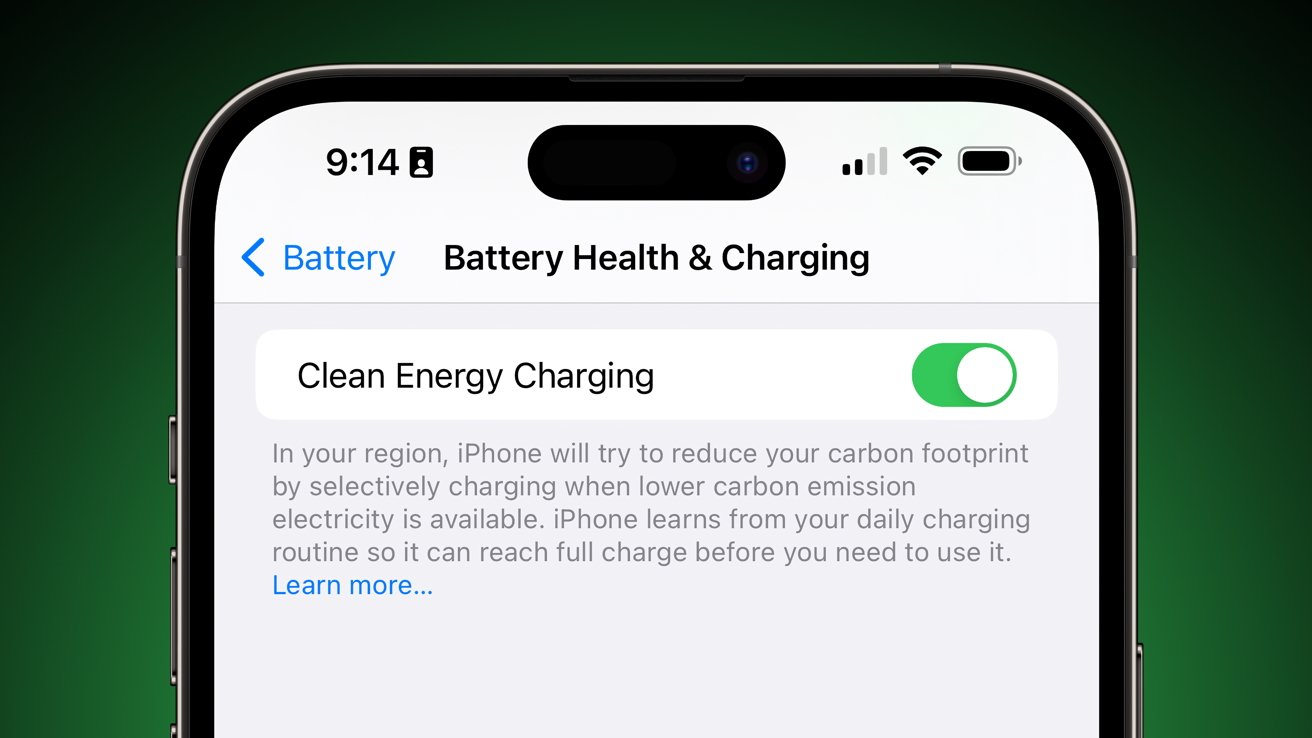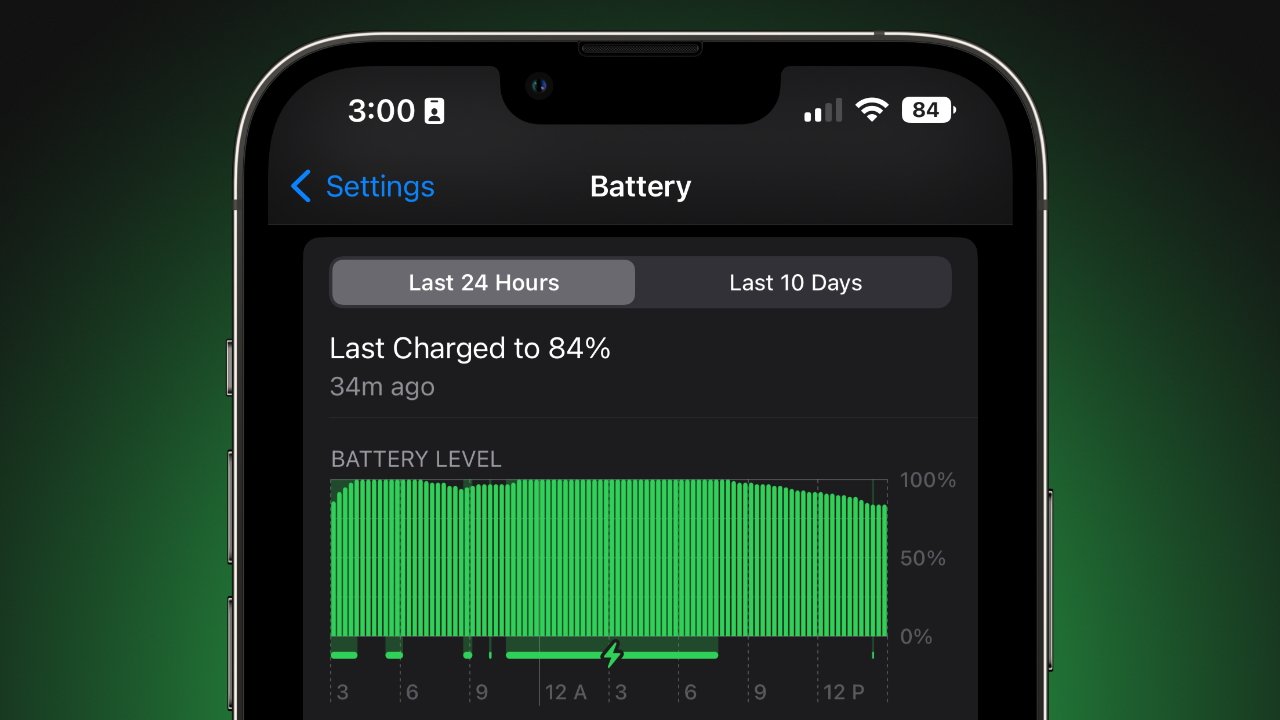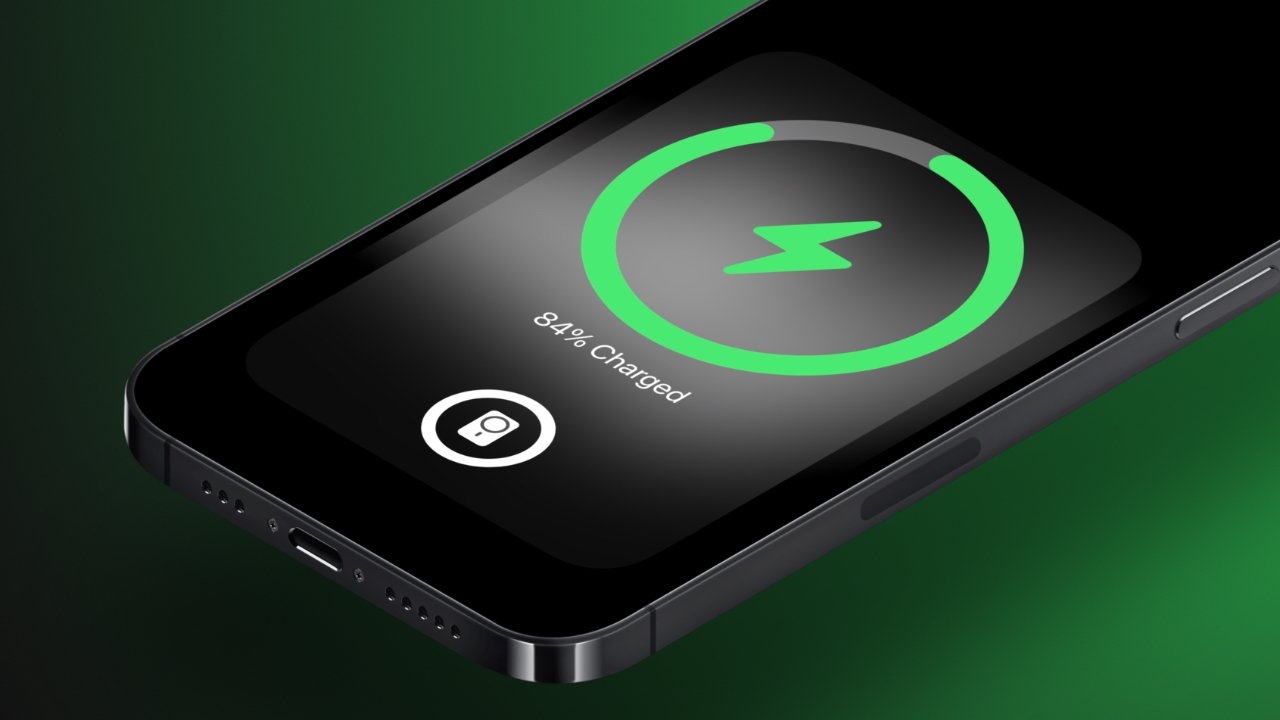What is iPhone Clean Energy Charging, and what you need to know
Apple quietly included a feature called Clean Energy Charging in iOS 16.1 and turned it on by default. Here's what you need to know about the environmentally conscious feature.

Clean Energy Charging helps reduce a user's carbon footprint
Apple was vocal about Clean Energy Charging when it announced iOS 16 in September 2022. It didn't launch to the public until October 24 with iOS 16.1, and it seemed the change went by without many users noticing -- until a recent social media storm.
Sunday, February 26, saw a slew of posts getting attention on Twitter about Clean Energy Charging. Users were vocal and angry, stating that they didn't want Apple to decide how they used energy for them.
The feature is opt-out, so if you don't want to participate in Clean Energy Charging, there is a simple toggle in settings to turn it off.
Before disabling the feature, you should learn about why Apple thinks Clean Energy Charging is important, how it works, and why you should consider leaving it on.
Despite claims made on social media, this feature does not reduce the effectiveness or speed of charging every time a device is plugged in. Instead, it is very selective based on the conditions mentioned before.
Posts and stories claiming that users had to turn off Clean Energy Charging after noticing how slow their iPhone was charging since iOS 16.1 are not accurate. This is based on a misunderstanding of the feature.

Charging only when clean energy is available will still result in a fully-charged device overnight
Users should not notice any difference in how their iPhone normally charges with Clean Energy Charging enabled.
In the event Clean Energy Charging activates at an inopportune time, users can shut it off and charge normally. If the feature is active, there is a notification available that can be long-pressed to turn it off for that charging session.
Clean Energy Charging doesn't activate without notifying the user. If the feature does suspend charging, the notification will say when the device will reach 100% -- similar to the Optimized Battery Charging feature.

Charging on a more deliberate schedule can be good for the environment and the device's battery
A carbon emission forecast isn't looking for clean energy sources and deciding if your electrical grid is "bad." It is looking for an average of carbon emissions over time and decides when the least carbon emissions are created for a given day -- which is net-cleaner. Basically, what the phone is assessing is peak versus non-peak electrical power usage times.
The iPhone feature will look for when carbon emissions are lower on average for the region and wait to charge the iPhone at full speed until then. However, there are other calculations taking place that will be discussed in the next section.
Reducing a user's carbon footprint doesn't mean the user has to ask their electric company to move to new energy sources so they can charge their iPhone faster. What it does mean is for the millions of iPhones in use across the United States, the collective user base can make a difference by charging their device more intentionally in very specific circumstances to reduce carbon emissions.
We'll refer to something as a Significant Location in the following list. This is a location determined using a device's location data over time to determine where a user spends most of their day.
Clean Energy Charging activates when:
Clean Energy Charging won't activate when traveling or in any new location outside of Significant Locations. Location data isn't shared with Apple and is only used for the algorithm.
To ensure Clean Energy Charging is active, Apple says the following features need to be activated:

Clean Energy Charging helps reduce a user's carbon footprint
Apple was vocal about Clean Energy Charging when it announced iOS 16 in September 2022. It didn't launch to the public until October 24 with iOS 16.1, and it seemed the change went by without many users noticing -- until a recent social media storm.
Sunday, February 26, saw a slew of posts getting attention on Twitter about Clean Energy Charging. Users were vocal and angry, stating that they didn't want Apple to decide how they used energy for them.
The feature is opt-out, so if you don't want to participate in Clean Energy Charging, there is a simple toggle in settings to turn it off.
Before disabling the feature, you should learn about why Apple thinks Clean Energy Charging is important, how it works, and why you should consider leaving it on.
What is Clean Energy Charging?
Clean Energy Charging is a feature that reduces a user's carbon footprint based on certain charging habits and local carbon emission forecasts. It is only active during extended charging sessions, like overnight, and in certain repeat locations, like at home or work.Despite claims made on social media, this feature does not reduce the effectiveness or speed of charging every time a device is plugged in. Instead, it is very selective based on the conditions mentioned before.
Posts and stories claiming that users had to turn off Clean Energy Charging after noticing how slow their iPhone was charging since iOS 16.1 are not accurate. This is based on a misunderstanding of the feature.

Charging only when clean energy is available will still result in a fully-charged device overnight
Users should not notice any difference in how their iPhone normally charges with Clean Energy Charging enabled.
In the event Clean Energy Charging activates at an inopportune time, users can shut it off and charge normally. If the feature is active, there is a notification available that can be long-pressed to turn it off for that charging session.
Clean Energy Charging doesn't activate without notifying the user. If the feature does suspend charging, the notification will say when the device will reach 100% -- similar to the Optimized Battery Charging feature.
What does "carbon emission forecast" mean, and what if my region doesn't have any clean energy?
Articles and various social media posts suggest that Apple is somehow punishing users who live in areas that have heavy carbon emissions. This is a deliberate misunderstanding of the feature and how it works.
Charging on a more deliberate schedule can be good for the environment and the device's battery
A carbon emission forecast isn't looking for clean energy sources and deciding if your electrical grid is "bad." It is looking for an average of carbon emissions over time and decides when the least carbon emissions are created for a given day -- which is net-cleaner. Basically, what the phone is assessing is peak versus non-peak electrical power usage times.
The iPhone feature will look for when carbon emissions are lower on average for the region and wait to charge the iPhone at full speed until then. However, there are other calculations taking place that will be discussed in the next section.
Reducing a user's carbon footprint doesn't mean the user has to ask their electric company to move to new energy sources so they can charge their iPhone faster. What it does mean is for the millions of iPhones in use across the United States, the collective user base can make a difference by charging their device more intentionally in very specific circumstances to reduce carbon emissions.
How charging is managed with Clean Energy Charging enabled
Multiple things have to be true before the iPhone suspends charging with Clean Energy Charging enabled. A machine-learning algorithm controls the feature.We'll refer to something as a Significant Location in the following list. This is a location determined using a device's location data over time to determine where a user spends most of their day.
Clean Energy Charging activates when:
- The user is in a Significant Location where extended periods of time are spent. meaning home, work, or school.
- The carbon emissions forecast tells the iPhone that heavy emissions are expected while the device is plugged in.
- Based on user behavior, the iPhone knows it will be on the charger for hours. i.e. while the user sleeps or is stationary at a desk.
- The device has time to wait for cleaner energy given when it was plugged in and when it expects to be unplugged, so it can still reach 100%.
Clean Energy Charging won't activate when traveling or in any new location outside of Significant Locations. Location data isn't shared with Apple and is only used for the algorithm.
To ensure Clean Energy Charging is active, Apple says the following features need to be activated:
- Go to Settings > Battery > Battery Health & Charging and make sure that Clean Energy Charging is on.
- Go to Settings > Privacy & Security > Location Services and make sure that Location Services is on.
- Go to Settings > Privacy & Security > Location Services > System Services and make sure that System Customization is on.
- Go to Settings > Privacy & Security > Location Services > System Services > Significant Locations and make sure that Significant Locations is on.
How to turn off Clean Energy Charging
- Open the Settings app
- Select Battery
- Select Battery Health & Charging
- Toggle off Clean Energy Charging

Comments
Apple introduces some nice feature.
A bunch of drooling mouth breathers on Twitter realize it exists and start spouting exaggerations, and mostly outright lies about what it does and why. Eventually they will start using words like ‘crippled’ and ‘bricked’ about what it did to their Apple device.
Lawyers file suit.
It has become a tired trope. Lawyers using morons on Twitter to astroturf a BS story so they can line their pocket.
It is highly unlikely that the cleanest time to charge will coincide with the most expensive time to charge. It physically doesn't make sense unless your area relies on purely renewable energy and nuclear power.
Renewables cost less to build - far less than coal, and there are no input costs once it's running. Maintenance and wear and tear, but that applies to all generation.
I mostly charge my phone at night when renewables tend to be less available, but then again general electricity usage is also lowest. That's why it's cheapest to charge at night in countries that bill by network demand.
we all know that for the life of the battery it's better to have fewer charging cycles.
but I spend a lot of time in my car, and of course I connect my phone via a wired connection for CarPlay.
except then the phone begins to charge.
it doesn't need a charge, my phone will last all day without a charge, just DO NOT CHARGE.
This "feature" is just what I want - "do not charge" except between certain hours. Except Apple have fixed the hours and given it a stupid divisive and unhelpful name.
The feature is good, and could be used all over the world and would improve the life of the batteries - it just needs the start/end times as changeable by the user.
As I have 33kWh of home battery storage controlling the charging based on the current mix of generation on the grid is pointless.
While I like the idea of this, it needs a lot more work especially to add timed charging.
The same goes for charging while I'm in my EV. That is like my home, powered by 100% renewable electrons.